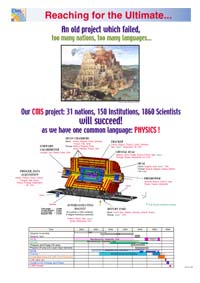| | The Ministry of Science, Research and Technology of Iran is in the final stages of forming a scientific collaboration with The European Organization for Particle Physics (CERN). The Institute for Studies in Theoretical Physics and Mathematics (IPM) will be the academic institute involved in this collaboration.
The primary objective is to have a team of Iranian scientists and doctoral students in particle physics participate in the the construction of Compact Muon Solenoid (CMS) detector at the Large Hadron Collider (LHC) accelerator.
The CMS collaboratin has members from 147 scientific institutions from 31 countries around the world and including our neighbors Turkey and Pakistan. The scientific goals of the project include the search for the origin of mass, CP violation and supersymmetric particles.
The Iranian contribution to the experiment is in two forms:
(1) Intellectual contribution mostly through the work of scientists and doctoral students in physics simulation and data analysis;
(2) Material and hardware contribution (in-kind contribution) to the contribution of mechanical parts and electronics for the Forward Hadron Colorimeter, which plays a crucial role in the search for the Higgs boson.
What is CERN?
CERN is the European Organization for Nuclear Research, the world's largest particle physics center. Founded in 1954, the laboratory was one of Europe's first joint ventures, and has become a shining example of international collaboration. CERN explores what matter is made of, and what forces hold it together. The Laboratory provides state-of-the-art scientific facilites for researchers to use. These are accelerators that accelerate tiny particles to a fraction under the speed of light, and detectors to make the particles visible.
LHC (Large Hadron Collider) Project
The LHC is an accelerator that brings protons and ions into head-on collisions at higher energies than ever achieved before. This will allow scientists to penetrate still further into the structure of matter and recreate the conditions prevailing in the early universe, just after the "Big Bang". The LHC will be built astride the Franco-Swiss border west of Geneva, at the foot of the Jura mountains, in front of the Alps.
CMS (Compact Muon Solenoid)
A General Purpose Detector at the LHC CMS (Compact Muon Solenoid) is a general purpose detector designed to run at highest luminosity at the LHC. The CMS detector has been optimized for the search of the SM Higgs boson over a mass range from 90 GeV to 1 TeV, but it also allows detection of a wide range of possible signatures from alternative electroweak symmetry breaking mechanisms. CMS is also well adapted for the study of top, beauty and tau physics at lower luminosities and will cover several important aspects of the heavy ion physics program.

| |
|





















